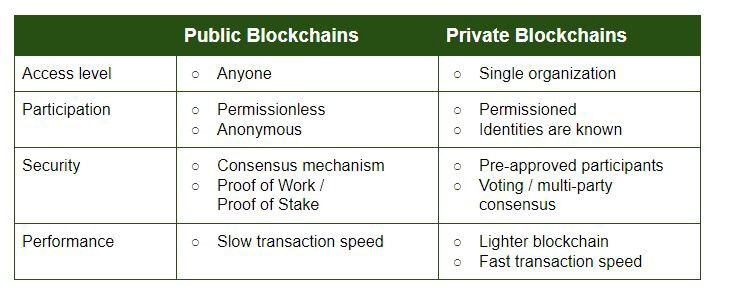
Public vs. Private Blockchain
The difference between public and private blockchain is related to the type of participants allowed within the network that maintain the ledger and execute the consensus protocol. One of the most critical questions often asked is the difference between a Public and Private Blockchain, and which of these two structures is most suited for a particular use case.

On one hand, transactions on a public blockchain are publicly transparent and immutable (data cannot be tampered with or altered in any way) but this could pose as a barrier for businesses that want to keep customers’ data confidential. On the other hand, private blockchain are much faster and scalable, but it is more centralized and could be prone to manipulation.
Public Blockchain
Public blockchain are those like the Bitcoin blockchain, where anyone can become a participant in the network: either by completing a transaction or by starting their own node of the blockchain and keeping track of the distributed ledger. With these blockchain, it means that all transaction details are public. A public blockchain is immutable where transactions are public and all nodes are equal whereas private blockchain is a network governed by a single entity. A public blockchain network is completely open and anyone can join and participate in the network. The network typically has an incentivizing mechanism to encourage more participants to join the network. Bitcoin is one of the largest public blockchain networks in production today.

Public blockchain, however, have their drawbacks. In a blockchain, each block contains a record of many transactions on the network. Creating new blocks gives out a reward, also known as the “miner’s fee”. The disadvantage to this is, these problems are very resource intensive and take a substantial amount of computational power to solve. Another disadvantage is the public nature of the blockchain itself. There is little to no privacy for transactions, or any regulation or criteria for participants to join. Public blockchain might be suitable for projects in the public domain (such as Blockchain), but not ideal for enterprise-level use cases.
Private Blockchain
The private blockchains are blockchains technologies which are operated by an organization. This is only accessible to an individual who has been granted the permission to use the blockchain by its proof. Private Blockchains are databases which are showcased as a distributed ledger. Private Blockchains, also known as permissioned blockchains, are mainly used internally by organizations looking to utilize blockchain technology to reduce costs. Obviously, for privacy purposes, businesses or individuals may not want the details of a transaction disclosed for anyone to look up, forever, regardless of whether the two parties engaged in the transaction manager to be anonymized by a number or single-use user name in the blockchain

The consortium or company running a private blockchain can easily, if desired, change the rules of a blockchain, revert transactions, modify balances, etc. The validators are known, so any risk of a 51% attack arising from some miner collusion in China does not apply. Transactions are cheaper, since they only need to be verified by a few nodes that can be trusted to have very high processing power, and do not need to be verified by ten thousand laptops.
One of the biggest disadvantages of a public blockchain is its complete openness. This type of transparency implies little to no privacy for transactions and supports a weak concept of security. Another drawback is the substantial amount of computing power that is necessary for the maintenance of the ledger. With so many nodes and transactions as part of the network, this type of scale requires extensive effort to achieve consensus.
-
Previous Post
ERC Token Development
-
Next Post
Hyperledger blockchain development










